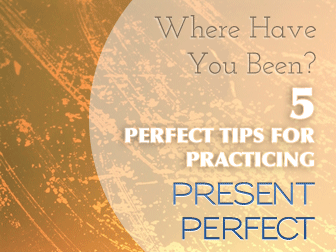How to Teach the Past Perfect Tense


Once they have gotten to this grammar point, they have mastered a lot and are moving into more and more complex grammatical structures and tenses. That being said, teaching Present Perfect tense can be one of the most challenging and intimidating grammar points to refine. Follow these 5 perfect tips for practicing Present Perfect tense, and your students will glide through this transition with ease.
Timelines are a great visual when introducing the different uses for Present Perfect. One of the best things about them is once you introduce them, you can continue to refer back to them and make it a point to have students do a timeline when they are struggling. It is one of the best ways to show the differences in usage that are usually so slight it can be hard to concretely define. A timeline shows the tense in a picture format for you, and once students get used to seeing them, they will begin to reference them for this point and other more advanced tenses. Be sure to provide several examples with your timelines, and using different colored markers will help accentuate your point. Also, timelines should always have a marker for now. Here are some examples of timelines that display their uses for Present Perfect tense.
The present perfect is used to discuss events that have just been completed at the moment of speaking:
I have just finished my homework:

It is often used to suggest that a past action still has an effect upon something happening in the present.
He has been in a car accident. (So now he is in the hospital)

It is often used to discuss events that have been happening over a period of time, but aren't finished yet.
Mary has worked as a teacher for 25 years.

The biggest issue students will have is the big decision between using Past tense and Present Perfect tenses. They will need constant comparisons, and the language you use will also help them to analyze what tense they need. There are lots of activities where students need to use both tenses accurately, and you can take that one step further by asking them to tell you why they have made which choice. Past tense is only used to express actions that are completed in the past with a time marker. That’s it. Present Perfect tense has several uses depending upon what you are trying to express. You can compare sentences and discuss how the meaning has changed with the tense choice. You may also want to discuss the time markers associated with each tense. Examples to analyze:
| I went to school yesterday. | I ate dinner late last night. |
| I have been at school since 7 a.m. | I have already eaten dinner tonight. |
‘Have you ever done something’ is my favorite way to introduce and review Present Perfect tense. It can be used over and over again, in different formats, with different experiences. It also creates a natural way in which to use the tense and again offers some distinction between how it is different from using past tense. This is also a good way to show the negative uses and short answers. Here are some examples:
Have you ever been to India? Yes I have. No I haven’t.
Have you ever eaten sushi? No, I haven’t ever eaten sushi. No, never.
Have you ever been angry at your brother? I sure have.
The possibilities for this activity are endless, and you can use worksheets, do mingling activities or do simple Q and A in rounds.
The time markers for Present Perfect tense are very important and need not be overlooked. Yet, for and since can confuse learners, so provide good examples for each usage where it applies.
There are a lot of ways to practice this with conversational activities or with fill in the blanks.
There are numerous ways in which to practice Present Perfect tense, and this is in part to its different uses. You’ll want to take the tense step-by-step and introduce one usage at a time and then practice it. Build upon that usage and introduce the next usage. Over a matter of weeks, you can practice the tense by providing a variety of activities that include conversation, writing, discussion, Q and A, and grammatical exercises. Use your creativity and incorporate activities that practice the tense as a whole when students are ready.
Take it in stride and move at the students’ pace. You may also be surprised by how many challenging grammatical questions they will pose to you. Do your homework and make sure you have a firm understanding of Present Perfect tense. Using these 5 tips for practicing Present Perfect tense will deliver great results.